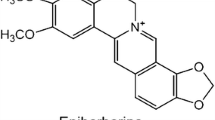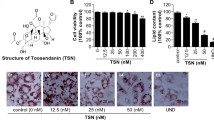Abstract
Fucosterol is a sterol constituent primarily derived from brown algae. Recently, the antiadipogenic effect of fucosterol has been reported; however, its molecular mechanism remains to be studied. Fucosterol effectively upregulated the phosphorylations of both adenosine monophosphate (AMP)-activated protein kinase (AMPK) and acetyl-CoA carboxylase (ACC), and downregulated the expression levels of lipogenesis-related factors. Moreover, fucosterol activated the major components of the Wnt/β-catenin signaling pathway, including β-catenin, disheveled 2 (DVL2), and cyclin D1 (CCND1), whereas it inactivated glycogen synthase kinase 3β (p-GSK3β) by stimulating its phosphorylation. In the presence or absence of fucosterol, the adipogenic transcriptional factors [peroxisome proliferator activated-receptor γ (PPARγ), CCAAT/enhancer binding protein α (C/EBPα), and sterol regulatory element binding protein-1c (SREBP-1c)] were upregulated by the inhibition of AMPK by compound C or the knockdown of β-catenin by siRNA. Overall, these data demonstrate that fucosterol prevents adipogenesis by mediating both AMPK- and Wnt/β-catenin-signaling pathways.
Similar content being viewed by others
References
Ejaz A, Wu D, Kwan P, Meydani M. Curcumin inhibits adipogenesis in 3T3-L1 adipocytes and angiogenesis and obesity in C57/BL mice. J. Nutr. 139: 919–925 (2009)
Kim SY, Kim AY, Lee HW, Son YH, Lee GY, Lee JW, Lee YS, Kim JB. miR-27a is a negative regulator of adipocyte differentiation via suppressing PPARgamma expression. Biochem. Bioph. Res. Co. 392: 323–328 (2010)
Gummersbach C, Hemmrich K, Kröncke KD, Suschek CV, Fehsel K, Pallua N. New aspects of adipogenesis: Radicals and oxidative stress. Differentiation 77: 115–120 (2009)
Ahmed W, Ziouzenkova O, Brown J, Devchand P, Francis S, Kadakia M, Kanda T, Orasanu G, Sharlach M, Zandbergen F, Plutzky J. PPARs and their metabolic modulation: New mechanisms for transcriptional regulation?. J. Intern. Med. 262: 184–198 (2007)
Farmer SR. Transcriptional control of adipocyte formation. Cell Metab. 4: 263–273 (2006)
Ceddia RB. The role of AMP-activated protein kinase in regulating white adipose tissue metabolism. Mol. Cell. Endocrinol. 366: 194–203 (2013)
O’Neill HM, Holloway GP, Steinberg GR. AMPK regulation of fatty acid metabolism and mitochondrial biogenesis: Implications for obesity. Mol. Cell. Endocrinol. 366: 135–151 (2013)
Hardie DG, Ross FA, Hawley SA. AMPK: A nutrient and energy sensor that maintains energy homeostasis. Nat. Rev. Mol. Cell Bio. 13: 251–262 (2012)
Pimentel GD, Ropelle ER, Rocha GZ, Carvalheira JB. The role of neuronal AMPK as a mediator of nutritional regulation of food intake and energy homeostasis. Metabolism 62: 171–178 (2013)
Kim W, Kim M, Jho EH. Wnt/ß-catenin signalling: From plasma membrane to nucleus. Biochem. J. 450: 9–21 (2013)
Christodoulides C, Lagathu C, Sethi JK, Vidal-Puig A. Adipogenesis and WNT signaling. Trends Endocrin. Met. 20: 16–24 (2008)
Baarsma HA, Königshoff M, Gosens R. The WNT signaling pathway from ligand secretion to gene transcription: Molecular mechanisms and pharmacological targets. Pharmacol. Therapeut. 138: 66–83 (2013)
Ling L, Nurcombe V, Cool SM. Wnt signaling controls the fate of mesenchymal stem cells. Gene 433: 1–7 (2009)
D’Alimonte I, Lannutti A, Pipino C, Di Tomo P, Pierdomenico L, Cianci E, Antonucci I, Marchisio M, Romano M, Stuppia L, Caciagli F, Pandolfi A, Ciccarelli R. Wnt signaling behaves as a “master regulator” in the osteogenic and adipogenic commitment of human amniotic fluid mesenchymal stem cells. Stem Cell Rev. 9: 642–654 (2013)
Ryan E, Galvin K, O’Connor TP, Maguire AR, O’Brien NM. Phytosterol, squalene, tocopherol content and fatty acid profile of selected seeds, grains, and legumes. Plant Food. Hum. Nutr. 62: 85–91 (2007)
Llaverias G, Escolà-Gil JC, Lerma E, Julve J, Pons C, Cabré A, Cofán M, Ros E, Sánchez-Quesada JL, Blanco-Vaca F. Phytosterols inhibit the tumor growth and lipoprotein oxidizability induced by a high-fat diet in mice with inherited breast cancer. J. Nutr. Biochem. 24: 39–48 (2013)
Zheng MM, Lu Y, Huang FH, Wang L, Guo PM, Feng YQ, Deng QC. Lipase immobilization on hyper-cross-linked polymer-coated silica for biocatalytic synthesis of phytosterol esters with controllable fatty acid composition. J. Agr. Food Chem. 61: 231–237 (2013)
Furlan CPB, y Castro Marques A, Marineli RdS, Maróstica MR, Jr. Conjugated linoleic acid and phytosterols counteract obesity induced by high-fat diet. Food Res. Int. 51: 429–435 (2013)
Misawa E, Tanaka M, Nomaguchi K, Nabeshima K, Yamada M, Toida T, Iwatsuki K. Oral ingestion of aloe vera phytosterols alters hepatic gene expression profiles and ameliorates obesity-associated metabolic disorders in Zucker diabetic fatty rats. J. Agr. Food Chem. 60: 2799–2806 (2012)
Balboa EM, Conde E, Moure A, Falqué E, Domínguez H. in vitro antioxidant properties of crude extracts and compounds from brown algae. Food Chem. 138: 1764–1785 (2013)
Hashim MA, Yam MF, Hor SY, Lim CP, Asmawi MZ, Sadikun A. Antihyperglycaemic activity of Swietenia macrophylla king (meliaceae) seed extracts in normoglycaemic rats undergoing glucose tolerance tests. Chinese Med. 8: 1–8 (2013)
Hoang MH, Jia Y, Jun HJ, Lee JH, Lee BY, Lee SJ. Fucosterol is a selective liver X receptor modulator that regulates the expression of key genes in cholesterol homeostasis in macrophages, hepatocytes, and intestinal cells. J. Agr. Food Chem. 60: 11567–11575 (2012)
Jung HA, Jin SE, Ahn BR, Lee CM, Choi JS. Anti-inflammatory activity of edible brown alga Eisenia bicyclis and its constituents fucosterol and phlorotannins in LPS-stimulated RAW264.7 macrophages. Food Chem. Toxicol. 59: 199–206 (2013)
Kalsait RP, Khedekar PB, Saoji AN, Bhusari KP. Isolation of phytosterols and antihyperlipidemic activity of Lagenaria siceraria. Arch. Pharm. Res. 34: 1599–1604 (2011)
Khanavi M, Gheidarloo R, Sadati N, Ardekani MR, Nabavi SM, Tavajohi S, Ostad SN. Cytotoxicity of fucosterol containing fraction of marine algae against breast and colon carcinoma cell line. Pharmacogn. Mag. 8: 60–64 (2012)
Kim MS, Oh GH, Kim MJ, Hwang JK. Fucosterol inhibits matrix metalloproteinase expression and promotes type-1 procollagen production in UVB-induced HaCaT cells. Photochem. Photobiol. 89: 911–918 (2013)
Kumar SS, Kumar Y, Khan MS, Gupta V. New antifungal steroids from Turbinaria conoides (J.Agardh) Kutzing. Nat. Prod. Res. 24: 1481–1487 (2010)
Jung HA, Jung HJ, Jeong HY, Kwon HJ, Kim MS, Choi JS. Anti-adipogenic activity of the edible brown algae Ecklonia stolonifera and its constituent fucosterol in 3T3-L1 adipocytes. Arch. Pharm. Res. 37: 713–720 (2014)
Kim MB, Song Y, Kim C, Hwang JK. Kirenol inhibits adipogenesis through activation of the Wnt/ß-catenin signaling pathway in 3T3-L1 adipocytes. Biochem. Bioph. Res. Co. 445: 433–438 (2014)
He Y, Li Y, Zhao T, Wang Y, Sun C. Ursolic acid inhibits adipogenesis in 3T3-L1 adipocytes through LKB1/AMPK pathway. PLoS ONE 26: e70135 (2013)
Ko SC, Lee M, Lee JH, Lee SH, Lim Y, Jeon YJ. Dieckol, a phlorotannin isolated from a brown seaweed, Ecklonia cava, inhibits adipogenesis through AMPactivated protein kinase (AMPK) activation in 3T3-L1 preadipocytes. Environ. Toxicol. Phar. 36: 1253–1260 (2013)
Zhang T, Sawada K, Yamamoto N, Ashida H. 4-Hydroxyderricin and xanthoangelol from Ashitaba (Angelica keiskei) suppress differentiation of preadiopocytes to adipocytes via AMPK and MAPK pathways. Mol. Nutr. Food Res. 57: 1729–1740 (2013)
Lee H, Bae S, Yoon Y. The anti-adipogenic effects of (-)epigallocatechin gallate are dependent on the WNT/ß-catenin pathway. J. Nutr. Biochem. 24: 1232–1240 (2013)
Wang XL, Wang N, Zheng LZ, Xie XH, Yao D, Liu MY, Yao ZH, Dai Y, Zhang G, Yao XS, Qin L. Phytoestrogenic molecule desmethylicaritin suppreßsed adipogenesis via Wnt/ß-catenin signaling pathway. Eur. J. Pharmacol. 714: 254–260 (2013)
Author information
Authors and Affiliations
Corresponding author
Rights and permissions
About this article
Cite this article
Song, Y., Oh, G.H., Kim, MB. et al. Fucosterol inhibits adipogenesis through the activation of AMPK and Wnt/β-catenin signaling pathways. Food Sci Biotechnol 26, 489–494 (2017). https://doi.org/10.1007/s10068-017-0067-5
Received:
Revised:
Accepted:
Published:
Issue Date:
DOI: https://doi.org/10.1007/s10068-017-0067-5




